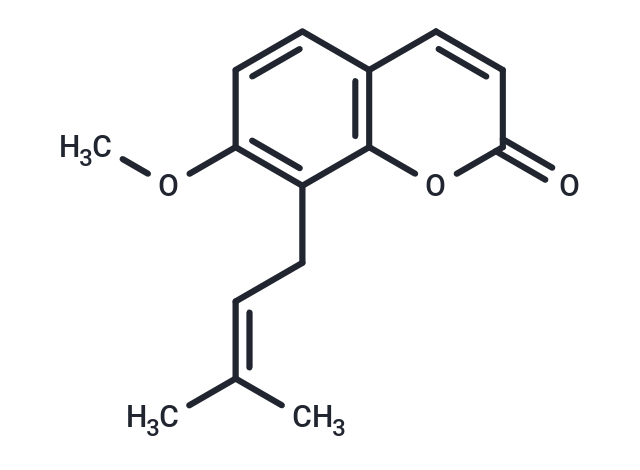Shopping Cart
- Remove All
 Your shopping cart is currently empty
Your shopping cart is currently empty
Osthole (Osthol), a potential inhibitor of histamine H1 receptor, has been shown to stimulate osteoblast proliferation and differentiation.

| Pack Size | Price | Availability | Quantity |
|---|---|---|---|
| 200 mg | $30 | In Stock | |
| 500 mg | $60 | In Stock | |
| 1 g | $97 | In Stock | |
| 2 g | $148 | In Stock | |
| 1 mL x 10 mM (in DMSO) | $36 | In Stock |
| Description | Osthole (Osthol), a potential inhibitor of histamine H1 receptor, has been shown to stimulate osteoblast proliferation and differentiation. |
| In vitro | The LD50 values of Osthole in various animals have been determined as follows: in rats, it exceeds 125 mg/kg when administered intravenously (i.v.); in rabbits, it is over 35 mg/kg (i.v.); and in dogs, it surpasses 150 mg/kg (i.v.). |
| In vivo | Osthol, when introduced to pre-washed rabbit platelets, inhibits platelet aggregation and ATP release induced by ADP, arachidonic acid, platelet-activating factor (PAF), collagen, ionophore A23187, and thrombin. In human osteoblasts, osthol promotes cell differentiation through the bone morphogenetic protein-2 / p38 and extracellular signal-regulated kinase 1/2 pathways. Additionally, in cell cultures, osthol suppresses the secretion of the hepatitis B virus by enhancing the glycosylation of HBsAg. |
| Cell Research | Osthole is dissolved in 96% ethyl alcohol and then sterilized through a 0.22 μg/mL filter and stored at 4°C as stock solutions for later dilution[1]. Peripheral blood samples are collected from participants between 7.00 and 9.00 a.m. on the first study day and these are concentrated in grouping tubes with K3EDTA. Fresh PBMCs are then prepared. Isolated cells are seeded on 24-well plates at 1×106 per well with RPMI-1640 and supplemented with 1% heat inactivated human AB serum, 1% gentamicin and 0.25% PHA. Active reagents are added to each well after 24 h and pure medium formed the control for each substance. Cells are then harvested after a further three days[1]. |
| Synonyms | Ostol, Osthol, NSC 31868 |
| Molecular Weight | 244.29 |
| Formula | C15H16O3 |
| Cas No. | 484-12-8 |
| Smiles | COC1=C(C\C=C(/C)C)C2=C(C=CC(=O)O2)C=C1 |
| Relative Density. | 1.126 g/cm3 |
| Storage | Powder: -20°C for 3 years | In solvent: -80°C for 1 year | Shipping with blue ice/Shipping at ambient temperature. | |||||||||||||||||||||||||||||||||||
| Solubility Information | Ethanol: 46 mg/mL (188.3 mM), Sonication is recommended. DMSO: 55 mg/mL (225.14 mM), Sonication is recommended. H2O: < 1 mg/mL (insoluble or slightly soluble) | |||||||||||||||||||||||||||||||||||
Solution Preparation Table | ||||||||||||||||||||||||||||||||||||
Ethanol/DMSO
| ||||||||||||||||||||||||||||||||||||

Copyright © 2015-2025 TargetMol Chemicals Inc. All Rights Reserved.